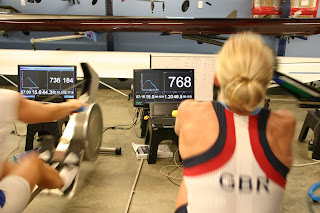When coaches do lactates on stationary ergometers and target the training zones on the water are they doing it right? Is there a direct correlation from stationary ergometer rowing to on water rowing?
Let me ask you a question and maybe you can start questioning some of the work that it is been going on to determine water training intensities.
When you row on a stationary ergometer you don't move like on the water. You spend a lot of energy to stop your body mass to change direction at the catch and release. The way the muscles are involve during the drive and the recovery on an stationary ergometer and a dynamic ergometer are different.
Also let me question something else. If you row on the water or on the RP3, you spend almost all the energy on the drive, have a longer drive and use the recovery to rest. If you row on a stationary ergometer you row shorter, a lot more on the second part of the stroke and also you spend plenty of energy to slow down and accelerate your body mass. Also you work a lot more on the recovery. This means that you can row at higher rate and longer on a dymanic erg as on the water and I believe accumulate more lactate.
My opinion is that measurements on stationary ergometer cannot be used as they are for water training. RP3 measurements are very similar to on water rowing and should be used for water training.












